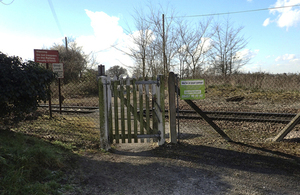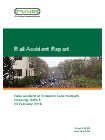Report 23/2016: Fatal accident at Grimston Lane level crossing
RAIB has today released its report into a fatal accident at Grimston Lane footpath crossing, Suffolk on 23 February 2016.

Image showing Grimston Lane level crossing
Summary
At 12:19 hrs on Tuesday 23 February 2016, a pedestrian was struck and fatally injured by a train on Grimston Lane footpath level crossing in Trimley St Martin, Suffolk.
The train was travelling from Ipswich to Felixstowe. The driver sounded the train’s warning horn soon after first seeing the pedestrian. The pedestrian raised his arm in apparent acknowledgment of the horn and continued to cross in front of the train.
It is not possible to be certain why the pedestrian started to cross the railway when he had insufficient time to do so. The RAIB has concluded that he was either unaware of the train at the time he decided to cross, or that he misjudged the time he needed.
He may have been unaware of the train because he did not look, possibly as a result of the skewed alignment of the crossing. On the other hand, it is possible that he was not in the best position to see the train when he made his decision to cross.
He may have misjudged the time he needed because he overestimated the time it would take for the train to arrive at the crossing, or he underestimated how long it would take him to cross.
The age and health of the pedestrian meant that he fell into the category of people considered, by Network Rail’s guidance, to be ‘vulnerable users’. Network Rail’s assessment of the user group for the crossing did not identify the need to make an additional time allowance for vulnerable users at the crossing. However, as the sighting time for approaching trains was sufficient even if such an allowance had been made, this was not causal to the accident.
Recommendations
The RAIB has made two recommendations to Network Rail. One relates to the importance of understanding and managing the effects of skewed alignment on the use of level crossings. The second relates to reducing the risk to vulnerable level crossing users in an expedient manner, as it upgrades passive crossings.
Additionally, the RAIB identified a learning point relating to the implementation of findings from recent RSSB research into encouraging pedestrians to make better crossing decisions.
Simon French, Chief Inspector of Rail Accidents said:
Our report into the tragic accident at Grimston Lane level crossing serves as a reminder of some important issues affecting the safety of footpath level crossings. I believe that the railway industry needs to better understand the extent to which skewed crossings affect the safety of users, particularly those classed as vulnerable. Since skewed crossings do not cross the line at 90°, they lengthen the path across the railway and require some users to look over their shoulder to see an oncoming train. There is evidence to suggest that these characteristics may make it more difficult for some elderly people to use such crossings safely.
The proportion of elderly people in the population is increasing and this is predicted to continue. It is therefore essential that this demographic change is allowed for in the risk management of level crossings over the years to come.
Notes to editors
- The sole purpose of RAIB investigations is to prevent future accidents and incidents and improve railway safety. RAIB does not establish blame, liability or carry out prosecutions.
- RAIB operates, as far as possible, in an open and transparent manner. While our investigations are completely independent of the railway industry, we do maintain close liaison with railway companies and if we discover matters that may affect the safety of the railway, we make sure that information about them is circulated to the right people as soon as possible, and certainly long before publication of our final report.
- For media enquiries, please call 01932 440015.
